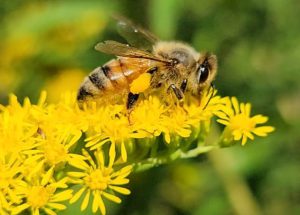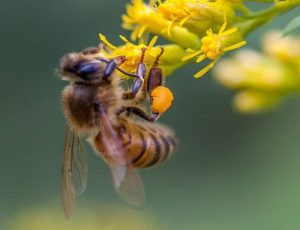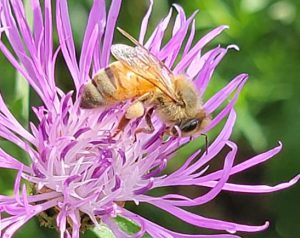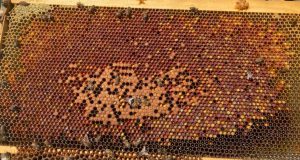A Nutritional Powerhouse
Jeannie Saum
Flower Pollen Grains to Bee Bread
Honey bees collect pollen from hundreds of different types of flowers including blooming trees, wild flowers, perennials and annuals. Pollen is the male seed of flowers. Flower pollen particles stick to the hairy bodies of the honey bees. As bees visit from flower to flower, pollen is transferred to other flowers, resulting in pollination. Without honey bees and other pollinators, our vegetable and fruit food sources would be drastically reduced – over 30% of these foods are dependent on insect pollination. In addition, up to 50% of plant food sources for animals in the wild rely on pollinators for their reproduction.
To collect pollen, the bees moisten the pollen with nectar and brush it down their bodies into baskets on their hind legs, packing it into larger particles called pellets. It takes two million flower pollen grains to make one pollen pellet. The bees can collect their weight in pollen. It takes one bee working eight hours a day for one month, to gather one teaspoon of pollen.
Pollen in the Hive
Once back at the hive, the bees offload their own pollen into waiting cells. Pollen spoils quickly, so the bees process the pollen into a longer lasting substance called bee bread. Mouth and mid-gut enzymes are added to ferment and convert pollens into a pasty consistency for longer storing. Nurse bees consume this bee bread so their glands can make royal jelly and food for the growing larvae. House bees also convert this bee bread further, by layering it in the cells with honey. It is a long lasting, stable food for easy digestion. This becomes the hive’s long-term food storage for times of scarcity. Bee colonies must have this vital protein, vitamin, lipid and mineral source to raise brood and perpetuate their existence.
History of Pollen Use by Man
The use of pollen by humans can be traced back to Ancient Egypt, Chinese Dynasties and Ancient Greece, used as food and in religious and cultural practices. The use of pollen has been part of the folklore and ceremonies of Native Americans in both North and South America, as well. In the 1970’s, it became popularly used by athletes based on research conducted by The British Sports Council reporting that it increased strength, stamina, and workout recovery. This study has not been supported by more recent research.1 Bee pollen has shown recent popularity as a dietary supplement for human health. Research does show that pollen has nutritional benefits.
Pollen: a Super Food
Pollen is considered a “Super Food” due to the wide range of nutrients it contains. Pollen has 40% protein, free amino acids, enzymes and vitamins, including B-complex and folic acid.2
According to researchers at the Institute of Apiculture, Taranov, Russia:“Honey bee collected pollen is the richest source of vitamins found in nature in a single food. Even if bee pollen had none of its other vital ingredients, its content of rutin (a bioflavinoid) alone would justify taking at least a teaspoon daily, if for no other reason than strengthening the capillaries. Pollen is extremely rich in rutin and may have the highest content of any source, plus it provides a high content of the nucleics RNA [ribonucleic acid] and DNA [deoxyribonucleic acid].”
Pollen, however, is relatively indigestible due its hard coat. Sprinkling fresh or dried bee pollen on cereal or yogurt is not going to benefit one’s health! Pollen must be ground, soaked in liquid at least overnight, or added to honey and made into bee bread, in order for one to be able to digest it and benefit from its nutrients.3 Heat destroys the active enzymes in pollen and reduces the nutritional value, so it should be eaten in fresh, freeze-dried or dried form. Fresh pollen must be kept refrigerated or frozen. Dried pollen should be kept in a sealed container, and will last up to one year.
Use as a Dietary Supplement
Serving suggestions vary from source to source, but most range from one tsp. to one tbsp. per day. It is suggested that one checks for an allergic reaction to the pollen by starting with one pollen pellet.
Pollen can be ground using a mortar and pestle or in a coffee grinder. It is too fine to be ground in a food processor. Ground pollen has a very grainy flavor that is not appealing to some. It can be flavored with cinnamon or other spices; stirred into juices, smoothies, cereal, yogurt and salad dressings; or sprinkled on toast topped with peanut butter or jelly. It can be mixed with honey to make tasty bee bread. It is also a beneficial ingredient in unbaked nutrition bars made with nut butters, honey and various nuts and grains.
Pollen in Skin care
Much has been written about the great benefits pollen has for our skin, but not much research can be found to back up its topical use on skin. It makes sense that due to the vitamins and nutrients found in pollen, eating it would help improve one’s skin. A healthy diet affects all our body parts. It can be used as an exfoliant in facial and body scrubs, due to its hard coat. But be wary of anything else you read. Look for footnotes that indicate cited research; you won’t find them in most cases!
Pollen for Health and Healing – What the Research Says
There are many health and healing claims about bee pollen that are often repeated in popular culture. There have been some animal studies in recent years showing that pollen inhibits harmful bacteria, regulates intestinal function, increases white and red blood cells, increases levels of hemoglobin, normalizes cholesterol and triglycerides, delayed/prevented cancerous tumors in mice and fights infection and disease.4 Most research studies, however, state that the evidence is still insufficient and that more research is needed. Both MedlinePlus5 and WebMD report that there is insufficient evidence to rate effectiveness for: appetite stimulation, premature aging, hay fever, mouth sores, joint pain, painful urination, prostate conditions, nosebleeds, menstrual problems, constipation, diarrhea, colitis or weight loss.6 At this point, medical research has not shown definitively that bee pollen is effective for any of these health concerns.
There is popular belief that bee pollen helps prevent allergic reactions. The theory is that pollen works like desensitizing allergy shots, when consumed six weeks before the allergy season. This theory falls apart, however, under closer examination. Consider this: the flower sources of pollen and honey vary from season to season. If one is allergic to say, goldenrod, which blooms in the Fall; then one would need to consume the previous Fall’s honey or pollen, in order to expose and desensitize one’s self to goldenrod pollen. There would be no goldenrod pollen in Spring or Summer honey or collected pollen! And when one buys pollen, it is not sorted or labeled as to what season it was collected in, or where.
There are NO human studies to verify that seasonal honey or pollen consumption can help with allergy symptoms. There are a few studies on mice that indicate pollen can inhibit certain parts of the allergic response, like inhibiting mast cell production,7 but overall, the claims are anecdotal at best. A few studies on pollen have shown promising results for certain treatments, but scientists still say more research is needed. A report from the Agronomic Institute, Faculty of Zootechnics, Romania, showed the immune-strengthening effects of bee pollen.8 A study on animals in 2014 indicated improved muscle protein and energy metabolism from ingestion of pollen.9 Since pollen cannot be duplicated in a laboratory, there is little incentive for research facilities to do studies on pollen, so duplicate, confirming research is hard to find.
The Bottom Line
Most claims about pollen have limited or no supportive research. However, pollen is a nutritional powerhouse and can be a healthy addition to one’s diet, if prepared correctly.
Pollen supports Health ~ Powered by Bees!
End Notes
1C Ulbricht, W Weissner, et. al. “An Evidence-Based Systematic Review of Bee Pollen.” Journal of Dietary Supplements. January 2009: 308. PubMed. 11 July 2017.
2C Ulbricht, W Weissner, et. al. 292.
3J Nelson. “Cracking the pollen case.” Voiceofthehive.com. 2008. 20. 11 July 2017
4Denisow, Bożena, and Marta Denisow-Pietrzyk. “Biological and therapeutic properties of bee pollen: a review.” Journal of the science of food and agriculture vol. 96,13 (2016): 4303-9. doi:10.1002/jsfa.7729
5“Bee pollen: how effective is it?” https://medlineplus.gov/druginfo/natural/78.html. 11 July 2017.
6“Bee Pollen Benefits and Side Effects.” www.Webmd.com/balance/. 11 July 2017.
7Y Ishikawa, T Tokura, et al. “Inhibitory effect of honeybee-collected pollen on mast cell degranulation in vivo and in vitro.”Forsch Komplementarmed Klass Naturheilkd. 2002 Feb;9(1):22-30. PMID. 11 July 2017.
8E Palos, Z Voiculescu, and C Andrei. “Comparative Studies Concerning Biochemical Characteristics of Beebread as Related to the Pollen Preserved in Honey.” Agronomic Institute, Faculty of Zootechnics,. 11 July 2017
9J Salles, N Cardinault, et. al. “Bee pollen improves muscle protein and energy metabolism in malnourished old rats through interfering with the motor signaling pathway and mitochondrial activity.” https://doi.org/10.3390/nu6125500
Nutrients. 2014 Dec 1;6(12):5500-16. PubMed. 11 July 2017.













